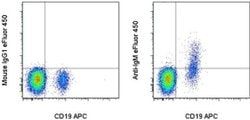CD184 (CXCR4) Monoclonal Antibody (2B11), eFluor™ 450, eBioscience™, Invitrogen™
Manufacturer: Fischer Scientific
Select a Size
| Pack Size | SKU | Availability | Price |
|---|---|---|---|
| Each of 1 | 50-112-4240-Each-of-1 | In Stock | ₹ 33,111.72 |
50-112-4240 - Each of 1
In Stock
Quantity
1
Base Price: ₹ 33,111.72
GST (18%): ₹ 5,960.11
Total Price: ₹ 39,071.83
Antigen
CD184 (CXCR4)
Classification
Monoclonal
Concentration
0.2 mg/mL
Formulation
PBS with 0.09% sodium azide; pH 7.2
Gene Accession No.
P70658
Gene Symbols
Cxcr4
Purification Method
Affinity chromatography
Regulatory Status
RUO
Gene ID (Entrez)
12767
Content And Storage
4° C, store in dark, DO NOT FREEZE!
Form
Liquid
Applications
Flow Cytometry
Clone
2B11
Conjugate
eFluor 450
Gene
Cxcr4
Gene Alias
b2b220Clo; C Cmotif chemokine; C X C motif chemokine; CC motif chemokine; CCmotif chemokine; CD antigen CD184; CD184; CD184 antigen; chemokine (C-X-C motif) receptor 4; chemokine (C-X-C) receptor 4; chemokine receptor; chemokine receptor (LCR1); chemokine receptor 4; chemokine receptor CXCR4; Cmkar4; CXC; CXC chemokine receptor; C-X-C chemokine receptor type 4; CXC motif chemokine; C-X-C motif chemokine receptor 4; CXCR4; CXC-R4; CXCR-4; D2S201E; FB22; Fusin; HM89; HSY3RR; HUMSTR; LAP3; LAP-3; LCR1; LESTR; Leukocyte-derived seven transmembrane domain receptor; leukocyte-expressed seven-transmembrane-domain; lipopolysaccharide-associated protein 3; LPS-associated protein 3; neuropeptide Y receptor Y3; neuropeptide Y3 receptor; NPY3R; NPYR; NPYRL; NPYY3R; PB-CKR; PBSF/SDF-1; pre-B-cell-derived chemokine receptor; SDF-1 receptor; Sdf1r; seven transmembrane helix receptor; seven-transmembrane-segment receptor, spleen; stromal cell-derived factor 1 receptor; WHIM; WHIMS
Host Species
Rat
Quantity
100 μg
Primary or Secondary
Primary
Target Species
Mouse
Product Type
Antibody
Isotype
IgG2b κ
Description
- Description: The 2B11 monoclonal antibody reacts with mouse and human CXCR4, also known as CD184, Fusin, LESTR, or HUMSTR
- Fusin is a member of the G-protein-coupled chemokine receptor family with seven membrane-spanning domains, and functions as a coreceptor for X4 HIV-1 entry into CD4+ cells
- In addition it has been shown to play a role in lymphocyte migration
- The ligand for CXCR4 is SDF1
- CXCR4 is required for maintece of granulocyte progenitors in the bone marrow and essential for B cell development
- Expression of CXCR4 is different between mice and human
- In the thymus CXCR4 is restricted to CD4+CD8+ cells while in the spleen predomit expression is found on B lymphocytes
- The monoclonal antibody 2B11 recognizes the amino terminus of CXCR4 and has been reported to have functional activity; it does not block SDF1a but causes internalization of the receptor
- Applications Reported: This 2B11 antibody has been reported for use in flow cytometric analysis
- Applications Tested: This 2B11 antibody has been tested by flow cytometric analysis of mouse thymocytes
- This can be used at less than or equal to 1 μg per test
- A test is defined as the amount (μg) of antibody that will stain a cell sample in a final volume of 100 μL
- Cell number should be determined empirically but can range from 10^5 to 10^8 cells/test
- It is recommended that the antibody be carefully titrated for optimal performance in the assay of interest
- CXCR4 (Fusin, LESTR, HUMSTR) is a member of the G-protein-coupled chemokine receptor family with seven membrane-spanning domains, and functions as a co-receptor for X4 HIV-1 entry into CD4+ cells
- CXCR4 has been proved to be the co-receptor for HIV-2's binding to CD4 through envelope glycoprotein gp 120 and promotes Env-mediated fusion of the virus
- In other cases, CXCR4 can even function as the only receptor for HIV-2's binding to the CD4 host cells
- CXCR4 is the receptor for the C-X-C chemokine CXCL12/SDF-1 that transduces a signal by increasing intracellular calcium ion levels and enhancing MAPK1/MAPK3 activation
- CXCR4 acts as a receptor for extracellular ubiquitin; leading to enhanced intracellular calcium ions and reduced cellular cAMP levels
- Also, CXCR4 is involved in hematopoiesis and in cardiac ventricular septum formation, and plays an essential role in vascularization of the gastrointestinal tract, probably by regulating vascular branching and/or remodeling processes in endothelial cells
- In the CNS, CXCR4 could mediate hippocampal-neuron survival and is involved in cerebellar development
- CXCR4 binds bacterial lipopolysaccharide (LPS) and mediates LPS-induced inflammatory response, including TNF secretion by monocytes
- Antibodies to CXCR4 block HIV-1 and HIV-2 fusion and infection of human target cells
- The amino-terminal domain and the second extracellular loop of CXCR4 serve as HIV biding sites.


